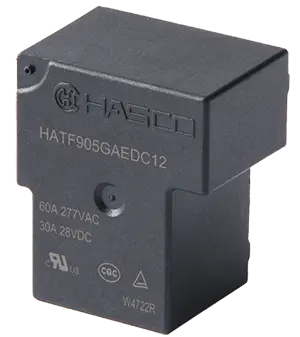
Features
- 4kVAC dielectric strength (between coil and contacts)
- Max. switching current 60A
- Compliant UL60947-4-1 5000A SCPD test
- Product in accordance to IEC 62368-1 available
- Apply to EV AC charging equipment

File No.:E75887

File No.:R 50514896

File No.:CQC22002338071

Contact Ratings
| Contact Arrangement | 1A |
|---|---|
| Contact Resistance | ≤50mΩ(1A 24VDC) |
| Contact Material | AgSnO |
| Contact Rating (Resistive) | 60A/277VAC |
| Max. Switching Voltage | 277VAC |
| Max. Switching Current | 60A |
| Max. Switching Power | 16620VA |
| Mechanical Life | 1×106 OPS |
| Electrical Life | See more details at “safety approval ratings” |
Characteristics
| Insulation Resistance | 1000MΩ (at 500VDC) | |
|---|---|---|
| Dielectric Strength | Between coil & contacts | 4000VAC 1min |
| Between open contacts | 1500VAC 1min | |
| Surge voltage(Between coil & contacts) | 6KV(1.2/50μs) | |
| Operate time (at nomi. volt.) | ≤15ms | |
| Release time (at nomi. volt.) | ≤10ms | |
| Humidity | 5%~85% RH | |
| Operation temperature | -40°C~+105°C | |
| UL Class F | Insulation System Class F | |
| Shock Resistance | Functional | 98m/s2 |
| Destructive | 980m/s2 | |
| Vibration resistance | 10Hz ~ 55Hz 1.5mm DA | |
| Unit weight | Approx. 30g | |
| Construction | Flux Tight Type, Sealed Type | |
Notes:
1) The data shown above are initial values.
2) Please find coil temperature curve in the characteristic curves.
Ordering Information
| HAT | F | 905G | A | E | DC | 12 – | 1 – | XXXX |
|---|---|---|---|---|---|---|---|---|
| Model | F:Class F | 905G:PCB Pins Only | A:SPST-NO | E:Flux Tight Type(vent hole sealed) S:Sealed Type Blank:Flux Tight Type(vent hole opened) | Coil:DC | Coil Voltage | Contact Gap:1=1.0mm Blank=Normal T:Long life & 1mm contact gap | Customer Code |
Notes:
1. PC board assembled with dust cover type and flux tight type relays can not be washed and/or coated.
2. Dust cover type and flux tight type relays can not be used in the environment with dust, or H2S, SO2, NO2 or similar gaseous environment etc.
Coil Data at 25°C
| Nominal Voltage VDC | Operate Voltage (Max.) VDC | Release Voltage (Min.) VDC | *Max. Allowable Voltage VDC | Coil Resistance Ω±10% |
|---|---|---|---|---|
| 6 | 4.50 | 0.60 | 7.80 | 30 |
| 12 | 9.00 | 1.20 | 15.60 | 120 |
| 24 | 18.00 | 2.40 | 31.20 | 480 |
| 48 | 36.00 | 4.80 | 62.40 | 1920 |
| 110 | 82.50 | 11.00 | 143.00 | 10800 |
Note:
“*Max Allowable Voltage”: The relay coil can endure max allowable voltage for a short period time only
Coil
| Coil Power | 1200mW |
|---|
Safety Approval Ratings
| Standard Type | Long Life Type | |
| UL&CUL | 60A/277VAC, 1s:9s, 40°C, 1×104 OPS 50A/277VAC, 1s:9s, 65°C, 3×104 OPS, GP Load 40A/277VAC, 1s:9s, 85°C, 3×104 OPS, GP Load 32A/277VAC, 1s:9s, 105°C, 3×104 OPS 30A/28VDC, 1s:9s, 85°C, 6×103 OPS 30A/24VDC, 1s:9s, 85°C, 3×104 OPS 2HP/250VAC, 1s:9s, 85°C, 5×104 OPS 8A/250VAC,Tungsten, 1s:59s, 65°C, 1×104OPS AC-15 6A/230VAC, 1s:9s, 65°C, 1×104OPS 32FLA/130LRA, 250VAC, 50°C, 3×104OPS, DP load. | 40A/277VAC, 1s:9s, 85°C, 5×104 OPS 2HP/250VAC, 1s:9s, 85°C, 5×104 OPS AC-15 6A/230VAC, 1s:9s, 65°C, 5×104OPS TV-8/277VAC, 1s:59s, 65°C, 5×104OPS 40A/277VAC, 1s:9s, 85°C, 3×104 OPS, GP Load 32A/277VAC, 1s:9s, 105°C, 3×104 OPS 30A/28VDC, 1s:9s, 85°C, 6×103 OPS 30A/24VDC, 1s:9s, 85°C, 3×104 OPS 8A/250VAC,Tungsten, 1s:59s, 65°C, 1×104OPS 32FLA/130LRA, 250VAC, 50°C, 3×104OPS, DP load. |
| TüV | 60A/277VAC, 1s:9s, 40°C, 1×104OPS 50A/277VAC, 1s:9s, 65°C, 3×104OPS 40A/277VAC, 1s:9s, 85°C, 3×104OPS 32A/277VAC, 1s:9s, 105°C, 3×104OPS 30A/24VDC, 1s:9s, 85°C, 3×104OPS 30A/28VDC, 1s:9s, 85°C, 6×103 OPS | 50A/277VAC, 1s:9s, 65°C, 5×104OPS 40A/277VAC, 1s:9s, 85°C, 5×104OPS 32A/277VAC, 1s:9s, 105°C, 5×104OPS |
| CQC | 60A/277VAC, 1s:9s, 40°C, 1×104OPS 50A/277VAC, 1s:9s, 65°C, 3×104OPS 40A/277VAC, 1s:9s, 85°C, 3×104OPS 32A/277VAC, 1s:9s, 105°C, 3×104OPS 30A/28VDC, 1s:9s, 85°C, 6×103 OPS | 50A/277VAC, 1s:9s, 65°C, 5×104OPS 40A/277VAC, 1s:9s, 85°C, 5×104OPS 32A/277VAC, 1s:9s, 105°C, 5×104OPS |
NOTES:
1. All values without specified temperature are at 25°C.
2. The above lists the typical loads only. Other loads may be available upon request.
OUTLINE DIMENSIONS, WIRING DIAGRAM AND PC BOARD LAYOUT. Unit: inch(mm)
Outline Dimensions

Wiring Diagram
(Bottom view)

PCB Layout
(Bottom view)

* The tolerance without indicating for PCB layout is always ±0.1mm.
Unless otherwise specified tolerances are:
| ≤1mm | >1mm and ≤5mm | >5mm |
| ±0.2mm | ±0.3mm | ±0.4mm |
CHARACTERISTIC CURVES
AMBIENT TEMPERATURE CHARACTERISTICS
AND COIL APPLIED VOLTAGE

COIL TEMPERATURE RISE

PACKAGING SPECIFICATION
| PLASTIC TUBE | OUTER CARTON | OUTER CARTON SIZE |
|---|---|---|
| 20PCS | 500PCS | L590mm*W205mm*H175mm |
APPLICATION GUIDELINES
Automatic Wave Soldering
* Wave solder is the optimum method for soldering.
* Adjust the level of solder so that it does not overflow onto the top of the PC board.
* Unless otherwise specified, solder under the following conditions depending on the type of relay.
| Preheat time 20°C-100°C | Rising slope 20°C-120°C | Decreasing slope Peak-150°C | Welding temperature 255°C-265°C |
|---|---|---|---|
| 90±5 seconds | <3°C/s | <4°C/s | 3~5s |
Hand Soldering
* Keep the tip of the soldering iron clean.
| Solder lron | 30W or 60W |
|---|---|
| lron Tip Temperature | Approx. 350°C 662°F |
| Solder Time | Within approx. 3 seconds |
* Immediate air cooling is recommended to prevent deterioration of the relay and surrounding parts due to soldering heat.
* Although the sealed type relay can be cleaned, avoid immersing the relay into cold liquid (such as washing solvent) immediately after soldering. Doing so may deteriorate the sealing performance.
Discard the dropped product
